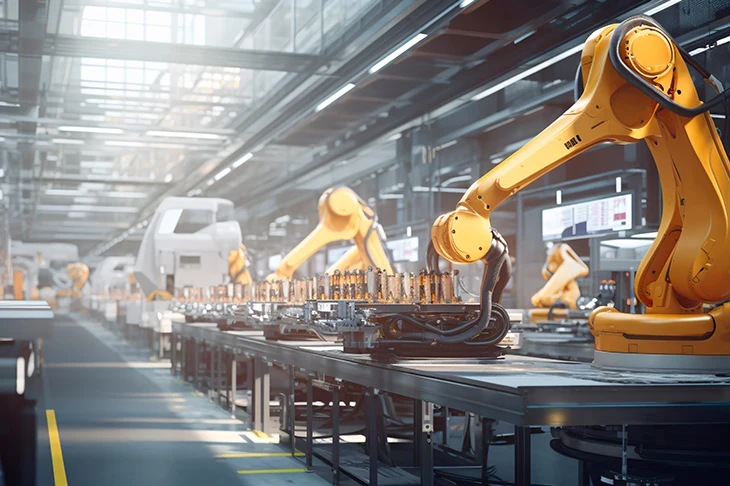- Sustainability
Reduce, Reuse, Recycle. Why not redesign?
Simon Hall, our Brand and Strategy Director, is discussing consumption and why the construction, industrial, and manufacturing sectors need to shift focus and hone in on design.

Excessive consumption and production have a huge impact on our global environment. So, how do B2B brands evolve in how they use resources and extract materials? Perhaps the production methods are just a consequence of something much more fundamental.
An introduction to consumption.
Consumption patterns play a pivotal role in shaping our global economic, social and environmental outcomes. But where some experience abundance, others struggle to meet basic needs. This is where the challenge lies: How can we strike a balance where everyone can thrive while preserving our natural resources?
A lot of responsibility relies on how we approach our infrastructure. How we design and build our world depends on businesses within our built environment sectors – industrial, construction and manufacturing firms carry a heavy load as their consumption and production habits dictate our sustainability outcomes. However, a transformation in consumption and production procedures requires a paradigm shift in managing resources, disposing of waste, and designing products.
The exponential rise in consumption over the last century has put a strain on our entire ecosystem and is threatening the future of our planet. With the global population expected to reach 9.7 billion by 2025, the demand for more resources is unprecedented. If we continue as we have been, our consumption patterns will require almost three planets to sustain.
We must seek new ways to produce and build what we need to decouple human well-being and economic growth from resource use and environmental impact. We’re already facing critical calls to reduce resource over-extraction, but the journey to change is complex. It requires new policies encouraging beneficial actions across our infrastructure, transformational change along global supply chains, and a seismic shift in consumer behaviour and lifestyles.
But waste and pollution do not exist by accident. Why can’t we consider new, less destructive ways to extract our resources? Why shouldn’t we review legacy solutions and products and make room for regenerative design?

#12.
The United Nation’s Sustainable Development Goals (SDG) are comprehensive and complex. However, the most poignant one for B2B brands is number 12. “To ensure good use of resources, improving energy efficiency, sustainable infrastructure, and providing access to basic services, green and decent jobs and ensuring a better quality of life for all.”
The impact of poorly designed products and systems weighs heavy – the manufacturing processes of yesterday are not built for tomorrow. However, the idea of going back to the drawing board is timely and costly, and reimagining and redesigning an entirely new way of working is a colossal task. But it can be done.
We work closely with Quaker Houghton, a global leader in industrial process fluids and a recognised name in the automotive manufacturing sector. Due to the industry’s electrification, a new, more sustainable production line needed to be realised to lower operational costs, limit resource extraction, reduce waste, and improve efficiencies overall. You can find out more here.
But what are the other incentives for reevaluating design and production processes? Well, The Extended Producer Responsibility (EPR) regulations encourage manufacturer accountability for product collection and recycling at the end of their first lifecycle. The EPR contributes to the development of reusable, recyclable, and compostable goods and sustainable construction and transportation processes. This financial incentive scheme seeks to ‘design out waste’ for good.
Designing a new world.
The transition to circular consumption and regenerative design is hindered by a cemented reliance on legacy products; such resilience within an organisation can impede progress. This is where actions need to be taken to change the mindset of an entire business, and it can only be done through the creation of effective ESG strategy development and an open-armed embrace of a sustainable culture.
If we’re to meet our environmental targets, the construction and manufacturing sectors must review design at a fundamental level. The construction industry alone is one of the largest contributors to global carbon emissions, and according to Architecture 2030, “the entire built environment accounts for 42% of global CO2 emissions annually.”
Let’s look past the challenges and impending crises for a moment. Why not reimagine a world that prioritises sustainable design in every decision?
We must prioritise passive infrastructure design and focus on energy-conserving manufacturing methods. We should be harnessing the power of technology and using the imposing yet soon-to-be-necessary benefits of AI to optimise energy usage and eliminate waste. We should also encourage the adaptive reuse and retrofitting of buildings, embrace biophilic design, and evolve our urban landscape into something green and biodiverse. This requires a careful review of materials and an effective lifecycle analysis. From building materials to industrial manufacturing, the decisions on which materials we use should come down to how much embodied energy and carbon are contained. All these things will encourage resilient and adaptive design and a built environment ready for the future.
